
Rama IX Collection
Gift from the artist
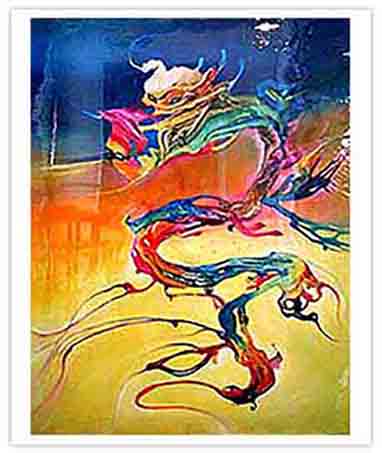
Form in Space No.2002Oil, acrylic on canvas80 x 60 cm.
WORK
BLACK & WHITE
SEMI ABSTRACT
Magical Forest
"The social character results from the dynamic adaptation of human nature to the structure of society. Changing social conditions result in changes in social character, that is in new needs and anxieties" - Erich Fromm
Watcharin Rodnit is a painter who falls in the category of artists who will not betray his conscience for any amount of silver. Throughout the centuries individuals endowed with strict professional integrity surfaced and graced the course of world art history. The most distinguished among them have left in their wake some remarkable achievements and pagefuls of anecdotes that keep inspiring those to whom humanism, aestheticism, and selfexpression are noble endeavours. Leonardo Da Vinci, Gauguin, Modigliani, the French female sculptor Claudel, the German poet Rilke, and Mozart come to mind as examples of both artistic excellence and self-determination. They have suffered a great deal because of their obsessive love for their craft, and their unbending will of steel. In the end they were destroyed by the world who ran counter to their convictions, and to whose demands they would not make concessions.
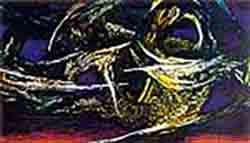

The Power of Nature, 1999
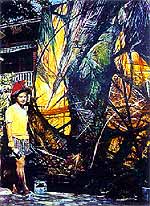
At 29 years of age, Watcharin Rodnit has accumulated an extensive and bulky body of work that consists of oversized, semi-abstract canvases which he stores in his small studio in Nonthaburi. When asked about his large holdings of unsold canvases, unperturbed he replies: "The day I become famous, they'll all sell like hot cakes!"This is no far fetched optimism on his part. Fame and fortune could just be lurking round the corner, awaiting him with open arms.
He was born on a farm of coconut and rubber trees in Surat Thani province. He manifested some artistic abilities as a child, drawing nature and scenes of his daily life. He filled the margins of his notebooks with cartoons of his teacher busy at the blackboard. His father never objected to his pictorial propensity; on the contrary, he encouraged him . He was himself fond of art and spent time fashioning attractive clay jars.
Young Rodnit loved the forest. He would disappear in the jungle for long hours. Those moments of solitary communion sharpened his familiarity with nature's endless forms and colours. He developed a keen appreciation for the greatness of the earth and such images were imprinted in his memory. He speaks of the forest in poetic terms that sum up his feelings: "In the South, the forest shines and the atmosphere is very hot.
Within its womb, I found my inspiration. In nature, all things are inter-related and interdependent ... the system of nature is holistic and balanced. It gives birth to a beauty that is alive with magical powers.
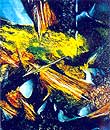
Early No.1, 1999
"My paintings reflect my emotions vis-a-vis nature's wondrous grandeur. I paint spontaneously. The freedom of my brusUstrokes best releases and transcribes the energy that wells up from the depth of my being, in a style which is distinctly my own. (Somewhat like the Chinese and Japanese calligraphers of old.) I search to achieve an equilibrium between emotions and reality."
Before 1999, his non-objective compositions were jammed, with very few openings and "vanishing points" for breathers. The forest of his mind was a vortex' raw, fantastic, primal. At that stage his view of life was a flux propelled by the after-effects of a big bang, and with no chance of repose. With dark colours and giant brush strokes, he externalised his inner life while discombobulating the faint-hearted gallery-goers and potential buyers who could not grasp the import of unleashed bursts of abstract expressionism. Still, beneath the jarring effects of colours and sweeps, Rodnit's creative drive was already impressive. After having looked at his paintings for a while, one is amazed at his vast mental and physical input. Every one of his canvases is loaded with energy.

Early No.2, 1999
He claims having a small studio; he works outdoors in the courtyard. Before embarking on a project, he might hew out some ideas with a pencil on paper. The rest comes to him freely. He feels a work through to completion and the large format of his paintings adds difficulty to the task of slowly harmonising shapes, colours, and contrast. When I think of him painting, I get images of a mystical dance. I am reminded of the Hindu concept of creation and destruction whereby Shiva (Nataraja) one of the gods of the Hindu triads, performs the cosmic dance to the rhythm of a small drum he holds in one of his hands.
Rodnit refers to his paintings as the steps of his life's voyage. Three years ago, he won a couple of prizes, in the Philips Morris Asean Competition and the Panasonic Painting Exhibition During the last five years, he completed his BFA and MFA at Silapakorn University. Three years ago, he started teaching art at Thaivyisit College, his initial alma mater where he first studied art after moving from Surat Thani to Bangkok. His joining the academic ranks caused him to cut his long black hair. He is no newcomer to wellknown exhibit venues in town. He participated in many group shows. His solo debuts were at Chulalongkorn University. In 1995 and 1997, his work was presented in Italy and Sri Lanka.
His most recent paintings indicate a lightening up of his vision. Something could be changing for the better in his private life, or else a sign of maturity that brings in a quietening of his compositions. His whirling, tightly packed abstractions are getting less dense, and open up onto patches of blue sky.
The viewer is now afforded with a kind of Ying-Yang play-a more comfortable yet intriguing dialogue. This pictorial move does not mean that on a daily basis Rodnit is striving less than before to make ends meet. He admits that for an uncompromising artist like him, it is hard going. But he is too much in love with abstract art to consider changing route. If he occasionally indulges in commercialisation, he paints flowers, running brooks, and portraits.
During quiet moments, he meditates. He reads poetry and stories about artists who had to stand up to the world, like Vincent van Gogh. So far his palette does not show signs of having been altered; it remains deep. A mutation in tonality might be the next indication to watch for regarding the evolution of his art.
Art for art's sake is Rodnit's point. He is not "playing a role that has been handed over to him" (Erich Fromm) by society. He is setting his own goals according to the dictates of his conscience. To the many who were born conformists, his lifestyle might look marginal and his priorities qustionable. While taken objectively, his life path is rich in self-fulfilling episodes that are truly his and him.
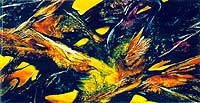
Hot Forest In Attract, 1998
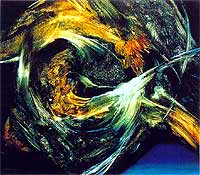
Songsarnwat, 1999
Erich Fromm describes the mechanism of delusion in his book Escape From Freedom, and consequently elucidates the stand of the artist, a lonesome figure in society: "Modern man seems, if anything, to have too many wishes .... All our energy is spent for the purpose of getting what we want and most people never question the premise of this activity: that they know their true wants. They do not stop to think whether the aims they are pursuing are something they themselves want. In school they want to have good marks, as adults they want to be more successful, to make more money, to have more prestige, to buy a better car, to go places and so on .... Yet all this bespeaks a dim realisation of the truth ... the truth that modern man lives under the illusion that he knows what he wants ... one of the most difficult problems any human being has to solve. Modern man is ready to take great risks when he tries to achieve the aims which are supposed to be "his", but he is deeply afraid of taking the risk and the responsibility of giving himself his own aims .... by conforming with the expectations of others, by not being different, these doubts about one's identity are silenced and a certain security is gained. However, the price paid is high.
"Giving up spontaneity and individuality result in a thwarting of life."
